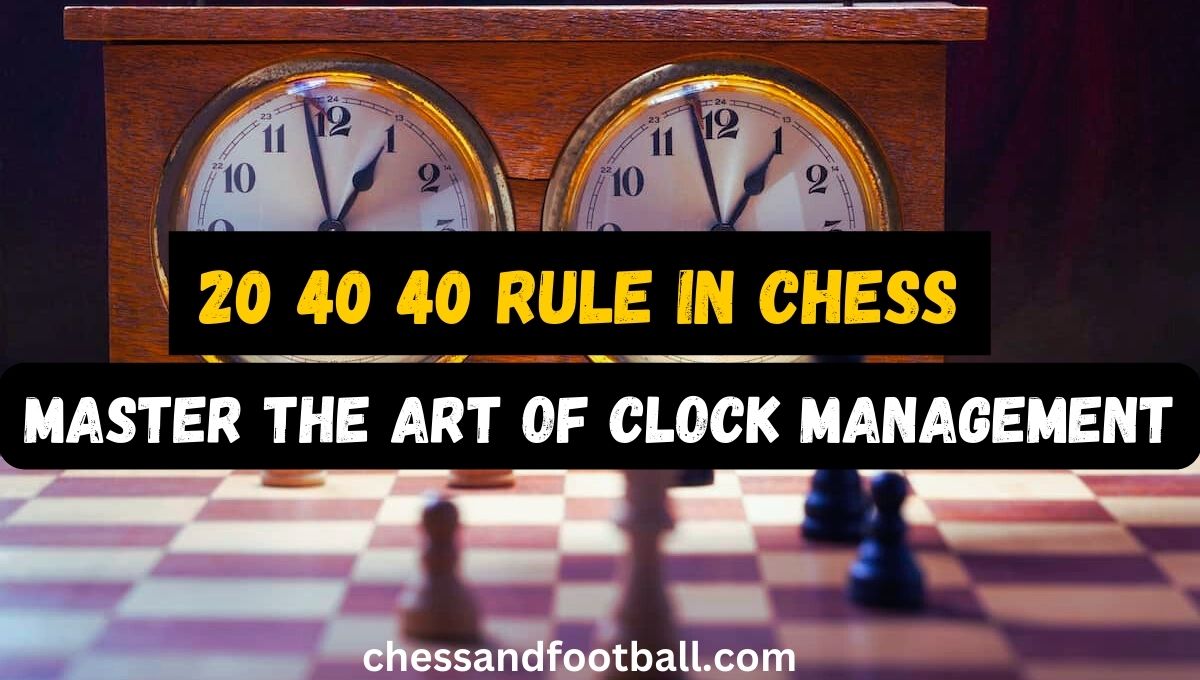The 20 40 40 Rule basically is not a rule but an idea or strategy that you can divide your game’s time into three phases: the opening, the middle game, and the endgame.
It suggests that if you are an under 2000 rating player you should spend roughly 20% of the game time in the opening phase, 40% in the middle game, and 40% in the endgame.
Why should you divide your clock time into 20 40 40?
Because it helps in managing time better.
Master-level players can manage the clock even in time trouble, but players rated 2000 and below lose their calm and composure when the clock starts ticking down to the last few seconds.
Their instincts for finding the best move quickly are not that developed.
Master-level players in time trouble, even if they can’t find the best move quickly, will at least find something that’s not bad or a blunder.
Plus, there are many clocks; in fact, most of them start beeping when it’s down to the last few seconds.
Most of the players get nervous when they hear that sound, and the chances of blundering increase tenfold in such a situation. So it’s better to avoid that situation altogether.
Why only 20% of the time for the opening phase?
In the 20 40 40 rule, there is the least time, i.e., only 20% for the opening phase because the opening is the least complicated phase in the whole game.
The primary focus of the opening is to develop pieces and control the center of the board, secure your king, and get into the middle phase at least with an equal position.
It is a simpler and more theoretical phase compared to the next two phases, so it shouldn’t take more than 20% of your time.
Is middle game and end game equally complicated in chess?
Yes, they are equally complicated; that’s why the 20 40 40 rule suggests equal time, i.e., 40% each for both these phases.
The middle game is characterized by complex strategic maneuvers and tactical play, and therefore, roughly 40% of your clock time should go to that phase of the game.
That’s enough time to think and not miss any tactics or win tempos.
In the endgame, the objective is to simplify the board and gain a material advantage.
The number of possible moves in the endgame is way too many, with fewer pieces, and a single mistake in this phase can prove disastrous and ruin the entire game.
So it is better to have plenty of clock time for this phase too.
Benefits Of The 20 40 40 Rule:
In chess, having a plan, even if it’s not a good one is better than having no plan at all.
The 20 40 40 Rule is a well-developed concept that helps players create a plan and manage their time more effectively during the game.
By understanding the different phases of the game and allocating your time accordingly, you can minimize errors and increase your chances of winning.
This rule has worked for many players, from beginners to professionals especially those who play very fast and blunder.
Following the 20 40 40 Rule can also help you develop your strategic thinking and decision-making skills by slowing you down and pushing you to find an even better move than the one that is in your mind.
It also encourages you to think about the game in a more structured and organized way, which can improve your overall chess playing abilities.
You can later study your games in chunks and give most of your time to phase of the game that you find yourself weakest in.
Overall, the 20 40 40 Rule is a valuable tool for any chess player looking to improve their game and win more matches.
Tips For Using The 20 40 40 Rule Effectively:
- The number one tip is don’t follow this rule religiously. 😀 If your opponent is playing aggressively, for example, you may need to spend more time in the middle game phase to respond to their attacks.
- Be flexible and adjust your timing based on the specific game and your opponent’s play style.
- 20 40 40 rule is just a guideline, and that you should always be willing to adapt to the situation at hand. If you find yourself struggling in a particular phase of the game, don’t be afraid to spend more time in that phase to improve your chances of winning.
Conclusion:
If you struggle with time management and often lose games on the clock, the 20 40 40 Rule is a great tool to help improve your game.
By allocating your time based on the three phases of the game, you can reduce errors and increase your chances of winning.
But remember that 20 40 40 rule is just a guideline, and it’s important to be flexible and adapt to the specific game and your opponent’s play style.
With practice and patience, you can master the art of time management in chess and become a better player.
By using this rule and trying many other different strategies, you can develop your strategic thinking and decision-making skills, which will not only help you win more games but also improve your overall chess playing abilities.
So, give the 20 40 40 rule a try, and see what change it brings in your game!

